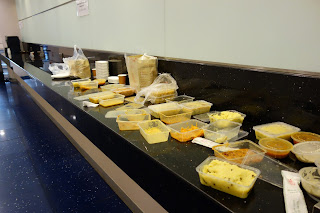I really wish that this post was a first-hand review of traditional Shanghai cuisine with details on local specialties and unusual culinary experiences. However, when I travel for work, eating is a haphazard affair driven by unbelievably long work hours, dietary requirements of a globally diverse team, and proximity. So, I offer you the following smorgasbord of business-travel eating. Bon Appetite!
Room Service Roasted Chicken
When I’m travelling and jet lagged, sometimes plain uncomplicated food is helpful to settle my stomach and help me sleep. This thyme-roasted chicken with steamed rice and asparagus from the room service menu was perfect as a first-night-in-town meal in my room before passing out from the 24 hour journey.
October Mid-Autumn Festival
This latest trip coincided with the Mid-Autumn Festival in China. This is one of the most important holidays in China and is associated with the legend of Houyi, and eating Mooncakes. Mooncakes are offered between friends or on family gatherings while celebrating the festival.
Wikipedia describes mooncakes as “round or rectangular pastries, measuring about 10 cm in diameter and 4–5 cm thick. A rich thick filling usually made from red bean or lotus seed paste is surrounded by a thin (2–3 mm) crust and may contain yolks from salted duck eggs. Mooncakes are usually eaten in small wedges accompanied by Chinese tea. Today, it is customary for businessmen and families to present them to their clients or relatives as presents, helping to fuel a demand for high-end mooncake styles. The caloric content of a mooncake is approximately 1,000 calories (for a cake measuring 10 centimeters (3.9 in), but energy content varies with filling and size.” I found them to be very, very heavy eating, with the red bean variety having a flavor similar to fig newtons, minus the fig seeds.
Hello Kitty Coffee
Starbucks is ubiquitous in Shanghai. There is a Starbucks on-site at the office complex, and even though I don’t drink Starbucks coffee at home, it’s the best available. We drink a LOT of coffee when we’re working in Shanghai, thanks to jet lag and long hours. And yes, I did actually stir my coffee with my Hello Kitty pencil. I know.
How to stock a mini-bar:
Because the cafeteria at the office serves local style food of questionable provenance, and breakfast in the hotel is expensive, I’ve mastered the art of stocking the mini bar with groceries.
Yogurt, fruit, raw vegetables and diet soda take precedence over the standard mini-bar fare.
Indian food with the Indians.
Chinese cuisine is not kind to vegetarians. On this trip, our team discovered India Kitchen, a local indian restaurant that delivers. The team has taken great pride in in ordering lunch every day…and single-handedly employing an entire fleet of delivery scooters.
Bakery section
Produce section
Red bean granola
And there you have it…the business travellers tour of eating in Shanghai.






























































